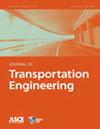Static and Dynamic Scheduling Method of Demand-Responsive Feeder Transit for High-Speed Railway Hub Area
Q Engineering
引用次数: 0
Abstract
Demand-responsive feeder transit (DRFT) is an emerging urban public transport mode with the advantage of offering flexible door-to-door services in the high-speed railway hub area. However, the existing bus scheduling schemes can hardly meet personalized and diversified passenger transfer demands in the station-city integrated high-speed railway hub, reducing the attractiveness of DRFT. This paper studies the DRFT scheduling problem considering static and dynamic travel demands under the background of mobility as a service (MaaS). An information-based DRFT system framework is proposed, where the K-means clustering algorithm is implemented to select target bus stops from regional road networks for passengers to get on and off. A two-stage mixed integer programming model is first formulated to generate operational routes and optimize the static and dynamic scheduling before and after departure. The objective functions reflect the operating benefits of public transport enterprises and the travel costs of passengers, and the demand characteristics in different driving directions are taken into account in the model. Then, an improved genetic algorithm is developed to solve the model, which is called the genetic algorithm-exact algorithm (GA-EA) in this paper. Finally, the proposed model and algorithm are evaluated using the case study of the Nanjingnan Railway Station area. The experiment results show that the optimal scheme can provide a 100% demand-response rate, reasonable service time, and valid driving routes. In addition, compared with GA, the average search time of GA-EA is shortened by 43.5% and the total objective function value is increased by 2.16%. The findings in this paper can provide practical guidance on DRFT scheduling and improve the efficiency of bus feeder service.高速铁路枢纽区需求响应支线交通静态与动态调度方法
需求响应式支线交通(DRFT)是一种新兴的城市公共交通方式,具有在高速铁路枢纽地区提供灵活的门到门服务的优势。然而,现有的公交调度方案难以满足站城一体化高铁枢纽个性化、多样化的换乘需求,降低了DRFT的吸引力。研究了移动即服务(MaaS)背景下考虑静态和动态出行需求的DRFT调度问题。提出了一种基于信息的DRFT系统框架,利用k均值聚类算法从区域路网中选择目标公交站点供乘客上下车。首先建立了两阶段混合整数规划模型,生成运行路线,优化出发前后的静态和动态调度。目标函数反映了公共交通企业的经营效益和乘客的出行成本,并考虑了不同行驶方向的需求特征。然后,提出了一种改进的遗传算法来求解该模型,本文称之为遗传算法-精确算法(GA-EA)。最后,以南京火车站区域为例,对所提出的模型和算法进行了评价。实验结果表明,该优化方案能够提供100%的需求响应率、合理的服务时间和有效的行驶路线。与遗传算法相比,GA- ea算法的平均搜索时间缩短43.5%,总目标函数值提高2.16%。本文的研究结果可为公交接驳调度提供实用指导,提高公交接驳服务效率。
本文章由计算机程序翻译,如有差异,请以英文原文为准。
求助全文
约1分钟内获得全文
求助全文
来源期刊

Journal of Transportation Engineering
工程技术-工程:土木
CiteScore
1.22
自引率
0.00%
发文量
0
审稿时长
3.6 months
期刊介绍:
Information not localized
 求助内容:
求助内容: 应助结果提醒方式:
应助结果提醒方式:


